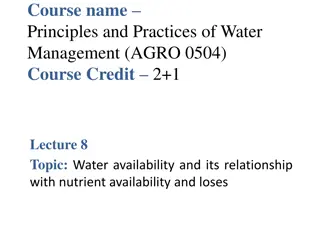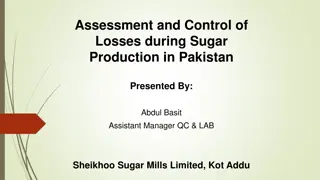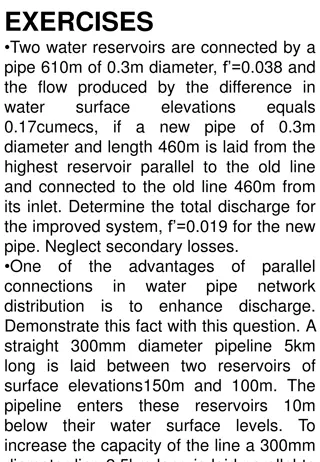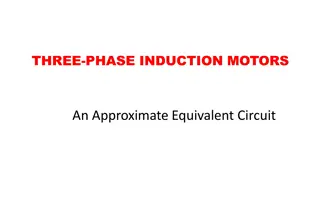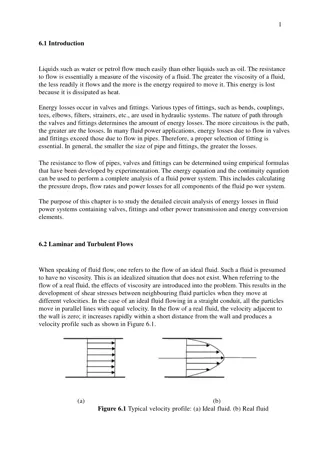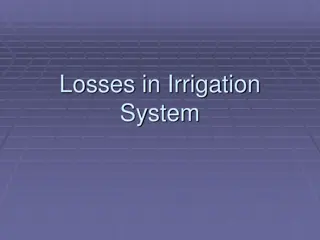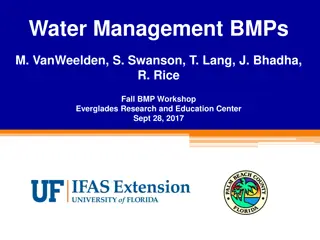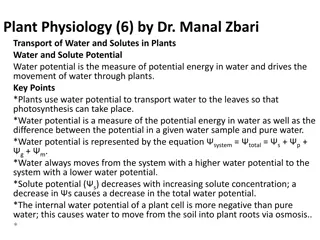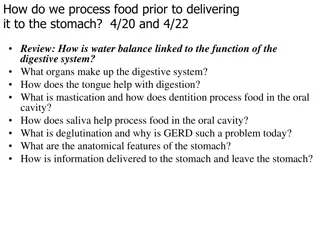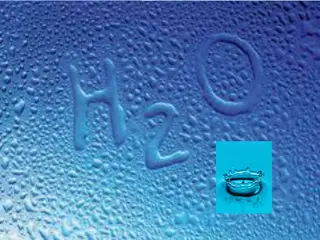Water Balance Calculations and Losses Analysis
Water balance calculations involve assessing commercial and physical losses in a water distribution system. The process includes basic calculations, evaluation of commercial losses such as metering inaccuracies and non-revenue water, as well as physical losses like leakage in transmission lines. Additional analyses cover input volumes, billed consumption, and DMA water supply data.
Download Presentation

Please find below an Image/Link to download the presentation.
The content on the website is provided AS IS for your information and personal use only. It may not be sold, licensed, or shared on other websites without obtaining consent from the author.If you encounter any issues during the download, it is possible that the publisher has removed the file from their server.
You are allowed to download the files provided on this website for personal or commercial use, subject to the condition that they are used lawfully. All files are the property of their respective owners.
The content on the website is provided AS IS for your information and personal use only. It may not be sold, licensed, or shared on other websites without obtaining consent from the author.
E N D
Presentation Transcript
Water Balance Calculations BASIC CALCULATIONS, COMMERCIAL AND PHYSICAL LOSSES
Content Basic Water Balance Calculation Commercial Losses Physical Losses Summary 2
1. Basic water balance calculation
IWA Water balance Billed metered consumption Billed authorised consumption Revenue water Billed unmetered consumption Authorised consumption Unbilled metered consumption Unbilled authorised consumption Unbilled unmetered consumption Unauthorised consumption Apparent losses (Commercial losses) Total System Input Volume Metering inaccuracies Non- revenue water Leakage in transmission and distribution lines Water losses Leakage and overflows at storage tanks Real losses (Physical losses) Leakage on service connections up to customer meters 4 WATER BALANCE CALCULATION 4
Basic NRW calculation ????? = ????? ??? # ??????????? = ????? ????? ???????? ) 24 ????? ????? ???? # ??????????? ) ??? ) 24 ?????????? ??? ??? ????? ????? ???????? ) 24 24 = ????? ????? ???????? ) ? ?? ??????? ????? ?????? ???? *Expressing NRW as a percentage of system input volume is a misleading and imprecise method, particularly in systems with intermittent supply and very low operating pressures. However, percentages may be used when looking internally at the improvements made throughout a project 5 WATER BALANCE CALCULATION 5
DMA Water Supply Input Volume The volume of water entering a DMA over a fixed period of time Calculated by: Physically reading the DMA s in- and outgoing meters at the start and end of a certain period (i.e. two weeks or one month) Analysing the flow data at the office (if meter fitted with GPRS / SMS) Try to coincide the period of time with the DMA billing period to be able to compare input volume with billed volume 6 WATER BALANCE CALCULATION
DMA Billed Water Consumption The volume of billed water in a DMA over a fixed period of time Calculated by: Billed volume taken from the monthly billing database Reading customer meters in a coordinated action Try and read the customer meters over the same period as the standard cycle DMA Month Customer ID Name Address Water Meter Size Last reading New Reading Last Meter Read Date New Meter Reading Date Days of Period Metered Consumption 05-01 05-01 05-01 05-01 05-01 05-01 05-01 05-01 05-01 05-01 05-01 05-01 05-01 05-01 05-01 05-01 12 10142370091 DOAN NGOC KHOA 12 10202930229 TRAN THI TUYET XINH 12 10243320151 VU HUY TU 12 11011020010 LAI SAN MIEN 12 11011020011 LUU HONG NGOC 12 11011020020 CHUA SUNG DUC 12 11011020022 NG NGOC SANG 12 11011020029 LE ANH TUAN 12 11011020030 CHENH A CAU 12 11011020040 NGUYEN AN MY 12 11011020041 NG BINH MINH 12 11011020050 DO TO 12 11011020060 TRAN AN TRAN 12 11011020070 LIEN CHIEU DUC 12 11011020071 NG THI HOANG 12 11011020075 HOANG VAN TAM DIEN BIEN PHU THANH THAI CC 830 SU VAN HANH PHU THO PHUTHO HONG BANG (SAN CHUA SUNG DUC) PHU THO PHU THO PHU THO PHU THO PHU THO PHU THO PHU THO PHU THO PHU THO 15 15 15 15 15 15 15 15 15 15 15 15 15 15 15 15 627 204 137 921 1345 2407 608 1189 73 139 1106 671 16/11/2011 204 27/10/2011 143 08/11/2011 958 21/10/2011 1397 21/10/2011 2469 21/10/2011 726 21/10/2011 1236 21/10/2011 85 21/10/2011 167 21/10/2011 1153 21/10/2011 50 21/10/2011 2454 21/10/2011 43 21/10/2011 971 21/10/2011 1077 21/10/2011 15/12/2011 28/11/2011 08/12/2011 21/11/2011 21/11/2011 21/11/2011 21/11/2011 21/11/2011 21/11/2011 21/11/2011 21/11/2011 21/11/2011 21/11/2011 21/11/2011 21/11/2011 21/11/2011 29 32 30 31 31 31 31 31 31 31 31 31 31 31 31 31 44 0 6 37 52 62 118 47 12 28 47 104 39 0 2415 36 971 1052 7 0 25 7 WATER BALANCE CALCULATION
International NRW assessment Category A1: potential for further NRW reductions is small Category A2: Further NRW reduction may be uneconomic Category B: Potential for marked improvements Category C: Poor NRW record; tolerable only if water is plentiful and cheap Category D: Highly inefficient; a comprehensive NRW reduction program is imperative and high- priority 8 WATER BALANCE CALCULATION
2. Commercial losses
Key components of commercial loss 10 COMMERCIAL LOSSES
Key components of commercial loss Water legitimately consumed but not billed, such as: Water fountains; Pipe and sewer flushing; Watering parks and gardens; Public drinking fountains; Fire fighting hydrants Unbilled Authorised Consumption Legitimate connections that were never entered into the billing system and are therefore never invoiced (intentional and accidental) Permanent or temporary meter bypass Illegal connections Illegal use of fire hydrants Unauthorised Consumption Volume under-recorded by revenue meter due to its condition Over-sized revenue meters Meter tampering (water theft) Meter Inaccuracies Corruption meter readers (collusion with customers) Meter reading errors (mistakes, or unreadable meters) Meter Reading Errors Data handling errors billing department Bills sent to wrong address Accounting Errors 11 COMMERCIAL LOSSES
Estimation of commercial loss Elements of commercial (apparent) water loss Commercial Loss Component Data Source Unbilled authorised consumption Data from billing department if metered (fire hydrants, pipe flushing, etc.) Thorough process analysis and analysis of billing data and database: check billing database against actual meter readings; check GIS property number v actual property in DMA v billing database Billing errors Check GIS property number v actual property in DMA v billing database Illegal connections Meter audit: test old meters (sample calibration) (on average meters under-read 5%) Meter inaccuracy age Meter audit: test class B or lower meters (sample calibration) Meter inaccuracy class Meter audit: check if meters are sized correctly Meter inaccuracy size Meter audit: check if meters are installed correctly Meter inaccuracy installation Analyse information from meter reading / meter replacement team Meter inaccuracy tampering Meter reading audit Data handling errors 12 COMMERCIAL LOSSES
Key components of physical loss 14 PHYSICAL LOSSES
Estimation of leakage in a DMA There are two methods to calculate the leakage volume in a DMA: 1. Top-Down subtract the Commercial Losses from the NRW 2. Bottom-Up Measure the Minimum Night Flow and subtract the Legitimate Night Flow applying a pressure correction factor Top-Down method is easier to calculate, but less accurate as many of the Commercial Loss components are estimated Bottom-Up method requires complex measurement, but gives an accurate leakage figure Best practice is to use both methods and compare as a check 15 PHYSICAL LOSSES
Estimation of leakage: top-down method To calculate an estimate of the physical losses, subtract the commercial losses from the NRW ????? ? ? ? ? ? ? ?????????? ??? ???? ?? = ??? ??????? 16 PHYSICAL LOSSES
Estimation of leakage: bottom-up method The Minimum Night Flow (MNF) is the lowest hourly average flow into the DMA over a 24-hour period, MNF is usually obtained between 2 and 4am, when most tanks have been filled and users are asleep The Legitimate Night Flow (LNF) is the customer minimum night consumption at the time of minimum night flow Domestic customers toilet flushing, washing machines etc; use a standard legitimate night time factor, or measured sample Large nightly users (such as night clubs or industries) manually read or log their meter or use a portable meter The Net Night Flow (NNF) is the DMA leakage at the time of minimum night flow: what remains after subtracting the LNF from the MNF Some of the leakage occurs on the customer s premises and therefore is not part of the utilities NRW. As such, the NNF should be divided into Utility leakage and Customer leakage 17 PHYSICAL LOSSES
Estimation of leakage: bottom-up method Identify the MNF (using a logged DMA meter) Identify the typical LNF Calculate the NNF = MNF LNF Estimate the Utility leakage UNNF = NNF Customer leakage As leakage is proportional to pressure, to represent the average leakage through the day the UNNF should be corrected with a pressure factor (pf), typically pf = average daily DMA pressure / average MNF pressure Average DMA leakage = UNNF*pf Varying Customer Demand Peak demand = lowest DMA pressure = lowest level of daily leakage Legitimate Customer Night Use Night demand = highest DMA pressure = highest level of daily leakage Leakage Varying with DMA Pressure throughout the Day Minimum Night Flow 18 PHYSICAL LOSSES
Estimation of leakage: bottom-up method Minimum Night Flow into DMA (MNF) = 13 m3/hour Number of domestic connections in DMA = 500 Average DMA occupancy rate = 5 Legitimate Domestic Night Use factor1 = 1.7 litres / person / hour Legitimate Domestic Night Use = 500 x 5 x 1.7 / 1000 = 4.25 m3/hour Measured Exceptional Night Use = 1 m3/hour Night leakage (L0) = 13 4.25 1 Measured night pressure (P0)) Measured average DMA pressure (P1) Therefore average DMA leakage (L1) = 7.75 x (15/25) Or, average DMA leakage (L1) = 7.75 m3/hour = 25 metres = 15 metres = 4.65 m3/hour = 111,6 m3/day 1 IWA Standard Factor Compare this result with the result of the Top-Down calculation 19 PHYSICAL LOSSES
Water balance calculations In order to understand NRW quantitative as well as qualitatively, it is essential to make a calculation of the water balance: the ratio of water produced to water sold While making the water balance, where possible, one should distinguish between the different causes of water loss: technical, administrative, illegal consumption, authorised consumption, etc. Depending on the resources available on can make water balance calculations in different ways The basic NRW calculation is easy, but gives only information on the total level of NRW. The outcome can be used to make an international comparison on NRW performance Estimates can be made of commercial losses by thoroughly studying the customer billing database and by field surveys Physical loss can then be calculated using total physical loss (top-down) or by more detailed field study (bottom up) 21 SUMMARY
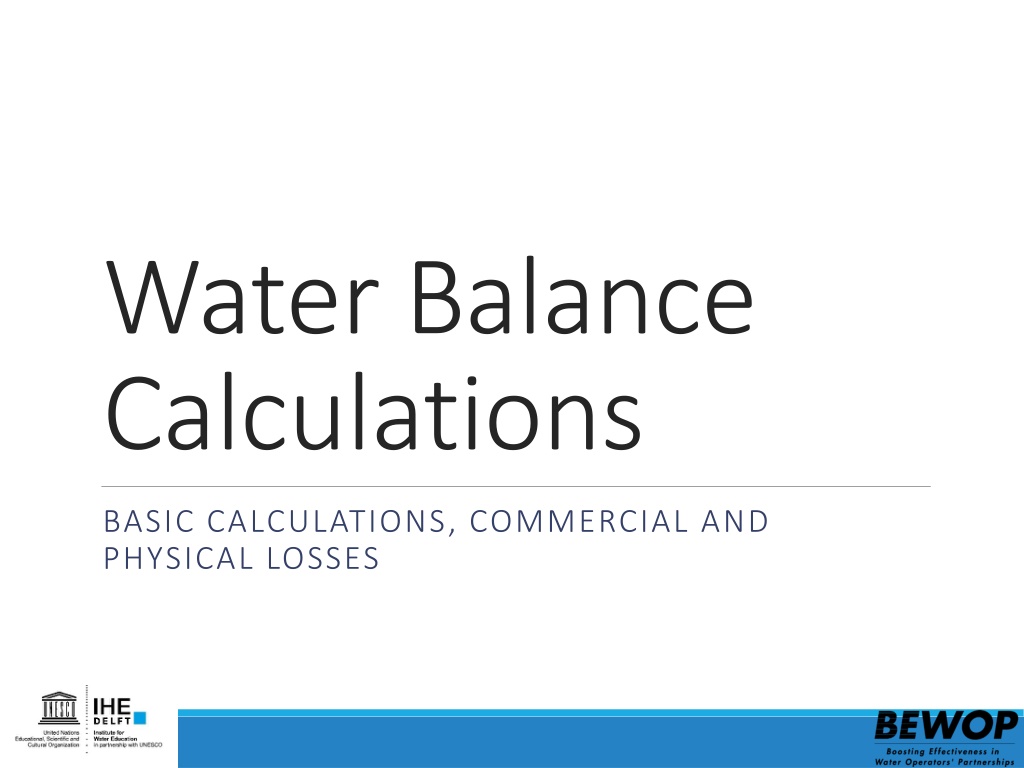
 undefined
undefined













